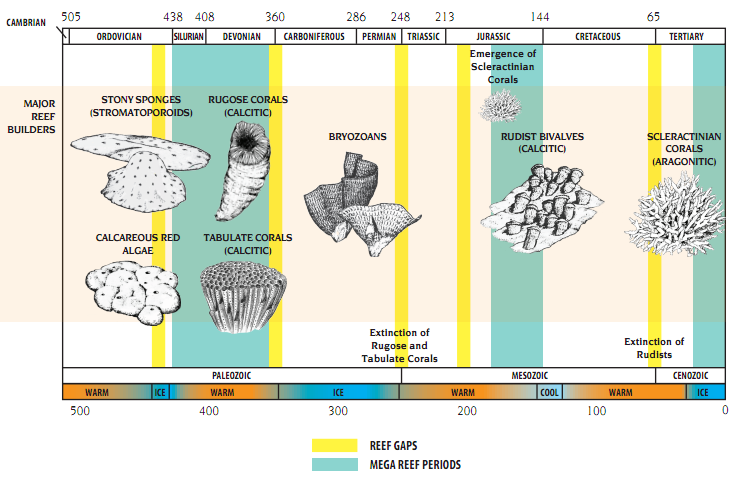RollingThunder
Gold Member
- Mar 22, 2010
- 4,818
- 525
- 155
- Thread starter
- #21
No, numbnuts, they went extinct, not "extginct".They went extginct? Really?Too bad you're just too retarded to understand this even when it is explained to you, walleyedretard.Poor delusional liar dingbat blunder, the answer is actually yes they did.
The coral type organisms that evolved in the world as it was a half a billion years ago went extinct. Do you even know what that means?
The current organisms that create coral reefs evolved to fill an empty ecological niche and they have no direct genetic connection with those very ancient coral reef building organizms, other than the genetic similarity that all life on Earth shares. The modern corals are not descended from those ancient 'corals'. Modern corals are evolved and adapted to current conditions and they are indeed severely threatened by these changes that mankind is creating on the Earth, warming oceans and increasing acidification.
That's what your denier cult blogs tell you but it isn't what the scientists at the Scripps Institute actually said at all. Their research indicated that pH levels show more localized variation than expected and they felt that this should be more thoroughly researched so that refuge areas less susceptible to acidification damage might be identified.
From the abstract:
Our data provide a first step toward crystallizing the biophysical link between environmental history of pH exposure and physiological resilience of marine organisms to fluctuations in seawater CO2. Knowledge of this spatial and temporal variation in seawater chemistry allows us to improve the design of OA experiments: we can test organisms with a priori expectations of their tolerance guardrails, based on their natural range of exposure. Such hypothesis-testing will provide a deeper understanding of the effects of OA. Both intuitively simple to understand and powerfully informative, these and similar comparative time series can help guide management efforts to identify areas of marine habitat that can serve as refugia to acidification as well as areas that are particularly vulnerable to future ocean change.
I found this interesting though, Bikini Atoll, remember that place? They detonated a big bomb there a few decades ago and you know what...the corrals there are rebounding quite well, this after experiencing a flash temperature of 55,000 degrees and a pressure wave that would flatten buildings for miles around. Turns out those corrals you're so worried about are way tougher then(sic) you're(sic) whiny sniveling little self.
Fifty years after the atomic blast that devastated the Bikini Atoll, vast expanses of corals in the area seem to be flourishing once again, much to the surprise of scientists.
American government scientists detonated a hydrogen bomb on the tiny island (a part of the Marshall Islands in the western Pacific) on March 1, 1954. Many of the natives were moved to Kili Island and today are compensated by the United States government.
Code-named Castle Bravo, the nuclear bomb was the most powerful ever exploded at the time, at 15 megatons, making it 1,000 times more powerful than the bomb dropped on Hiroshima in World War II. The massive explosion vaporized everything on three islands, raised water temperatures to 55,000 degrees and left a crater that was 1.2 miles (2 kilometers) wide and 240 feet (73 meters) deep.
If ever anyone wanted any proof of your retardation, this bit here would suffice.
World wide extinction events mean that all of the coral died off and it took literally millions of years for a replacement organism to evolve to fill that ecological niche. Whereas one bomb blast may destroy the local life in the area of the blast but after a very little time the surrounding and surviving life forms in the vast ocean re-colonize the area and fill in the hole the bomb blasted in the local ecology. But you 'think', in your own peculiar retarded and misspelled way, that that coral recovery means that: "those corrals you're so worried about are way tougher then(sic) you're(sic) whiny sniveling little self." LOLOL...you are such a complete flaming retard, walleyed, it's pathetic....
LOL....you seem even more confused than usual, walleyedretard. "Fossil corals", really? 'Fossil' is defined as the preserved remains or traces of animals, plants, and other organisms from the remote past. So "fossil corals" from half a billion years ago are rare. Wow, big surprise there. What exactly does any of your drivel have to do with the fact that coral reef structures completely disappear from the fossil record for millions of years following some of these major extinctions?Actually poor dingbat delusional silly person, the fossil corals from the Cambrian exist but are quite rare (as are MOST fossils from that era, fossil creation is actually quite rare, you'd know that were you educated), they begin to turn up with regularity around the Ordovician through the Silurian period and the dominant type of coral at that time was the Rugose variety.
You are correct that the Rugose variety went extinct at the PT boundary but the Scleractinian variety (which evolved at the same time as the Rugose) was able to fill the niche quite nicely. You really need to learn how to crack a book boyo, wiki isn't detailed enough for the type of knowledge you need to carry on a useful discussion.
Your demented and misplaced faith in your own mental prowess is extremely amusing sometimes. You are a really classic example of a victim of the Dunning-Kruger Effect.
Introduction to the Scleractinia
Scleractinian ("hard-rayed") corals first appeared in the Middle Triassic and refilled the ecological niche once held by tabulate and rugose corals. They are probably not closely related to the extinct tabulate or rugose corals, and probably arose independently from a sea anemone-like ancestor. Their pattern of septa differs markedly from that of the Rugosa, being basically six-rayed. For this reason, scleractinians are sometimes referred to as hexacorals.
Last edited:






